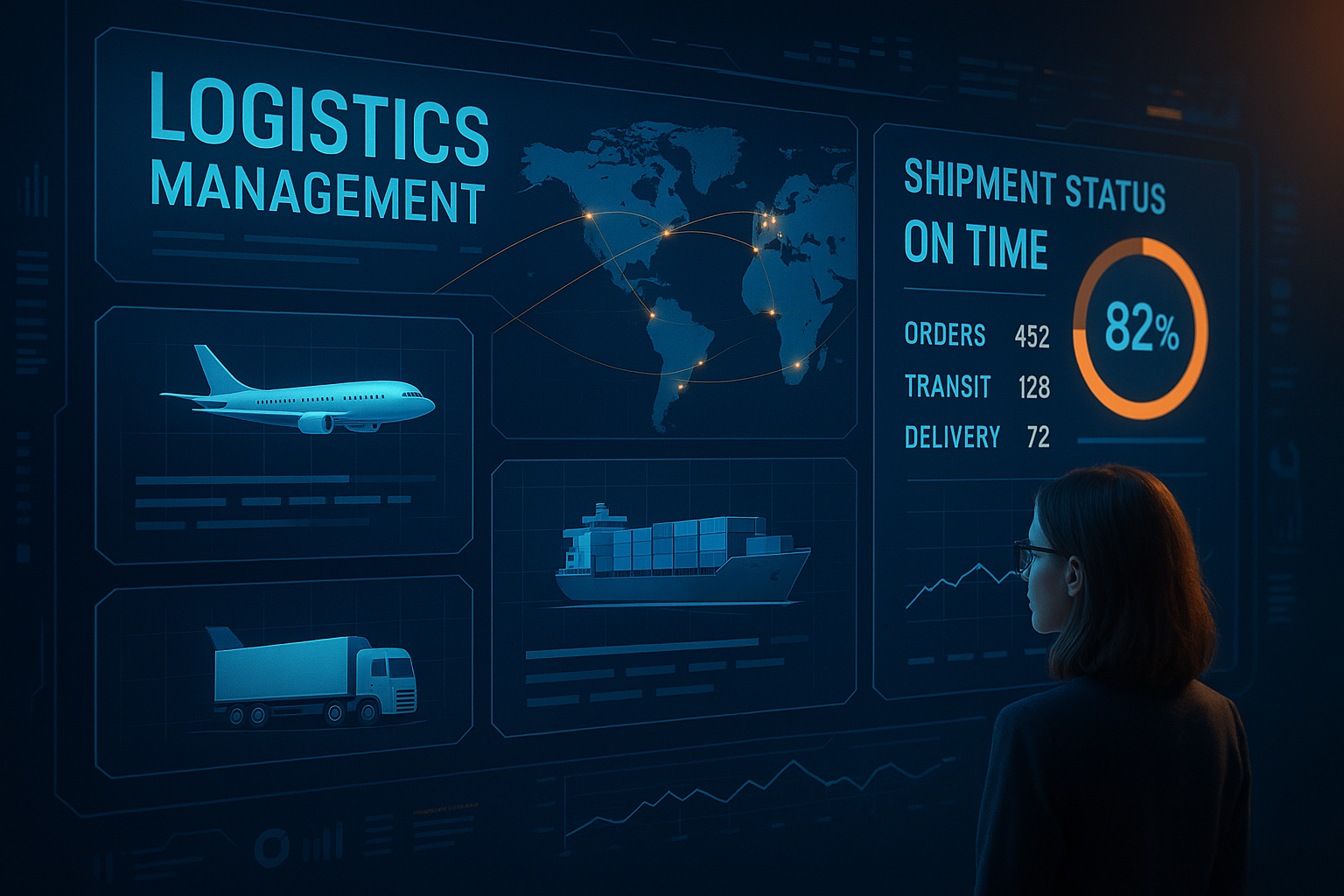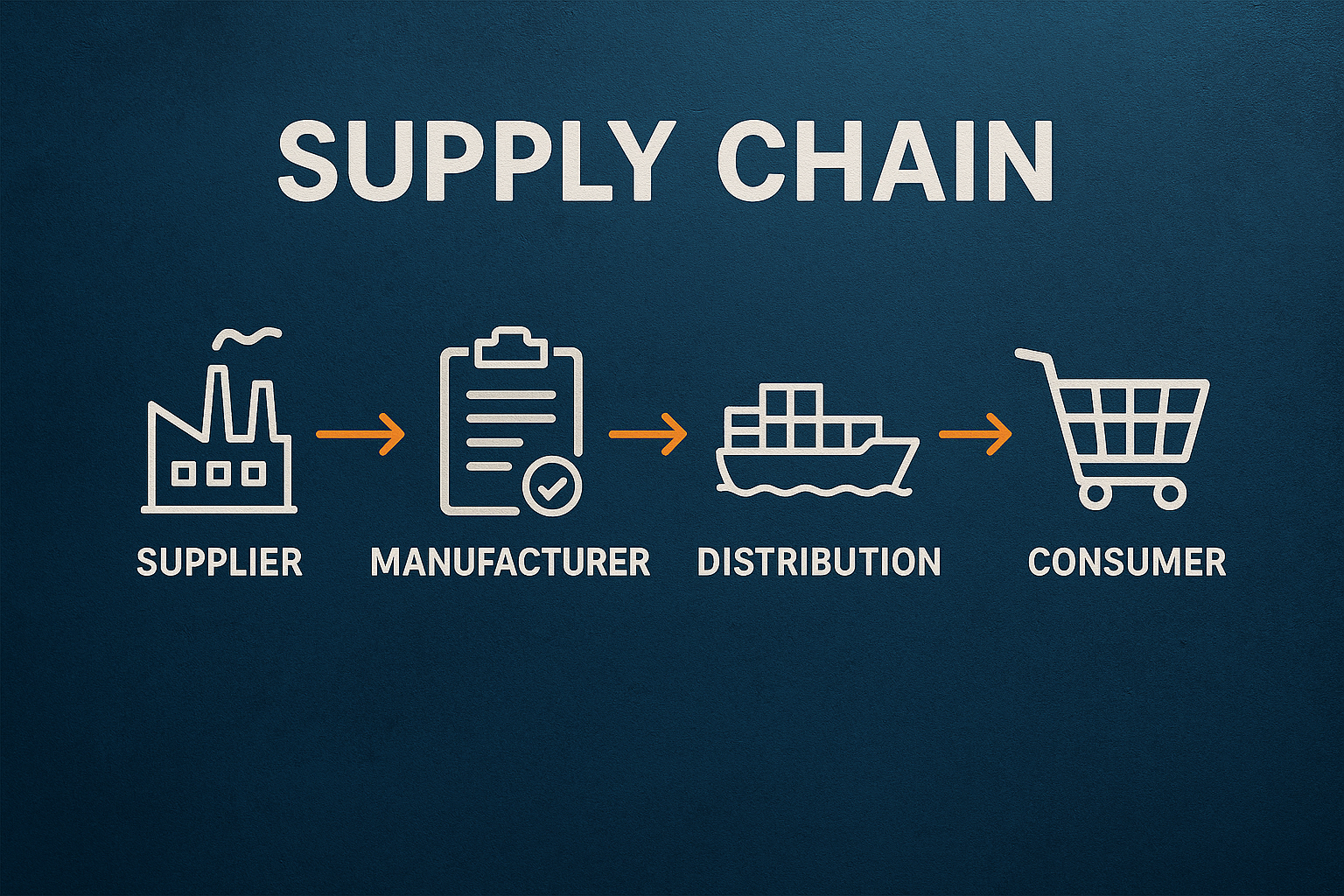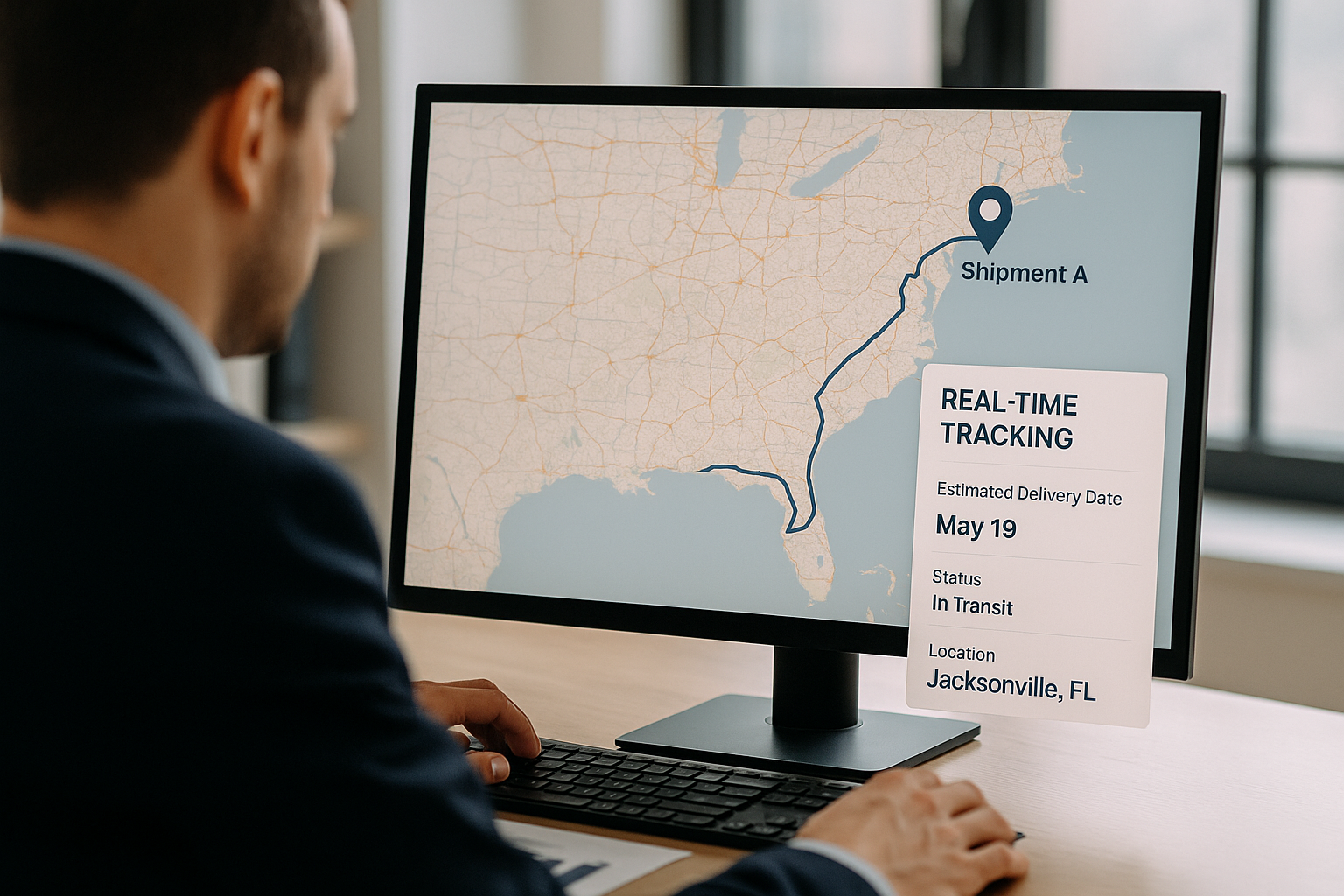Efficient freight management is at the core of successful logistics operations, ensuring the seamless movement of goods from origin to destination.
Real-time tracking has emerged as a game-changer for enhancing operational efficiency, improving customer satisfaction, and ensuring overall logistics success.
This article discusses the importance of real-time tracking, outlining its benefits and explaining how businesses can leverage it to achieve freight management success.

Let's Get Straight to the Point
Real-time tracking is essential for freight management success. It offers unparalleled visibility, proactive problem-solving, and improved customer satisfaction.
It optimises logistics processes by enabling timely updates, reducing costs, and enhancing operational efficiency through automation and real-time tracking.
Businesses that use real-time tracking systems can streamline their supply chains, address potential delays, and build customer trust through accurate and reliable service.
By implementing the right freight management system, companies can achieve cost savings, deliver an exceptional customer experience, and maintain a competitive edge in the logistics industry.
What is Freight Management and Why is it Important?
Freight management refers to the comprehensive process of planning, coordinating, and overseeing the transportation of goods.
It involves several strategic tasks, including selecting carriers, managing routes, and ensuring timely deliveries.
1. The Importance of Freight Management
Timely Deliveries: Effective freight management ensures goods are delivered on time, maintaining the integrity of the supply chain and meeting customer expectations.
Cost Efficiency: By optimising the logistics process, businesses can achieve significant cost savings, reduce operational expenses, and improve profitability.
Customer Trust: A well-executed shipping process builds customer confidence, improving customer satisfaction and long-term loyalty.
2. Real-Time Tracking in Freight Management
Integrating real-time tracking technology into freight management enhances operational control and fosters data-driven decision-making.
From mitigating delays to providing unparalleled visibility into the logistics process, real-time tracking ensures efficient operations and empowers businesses to stay competitive.
3. Definition of Real-Time Tracking
Real-time tracking refers to using advanced technologies, such as GPS, RFID, and mobile tracking, to monitor shipments' exact location and status in real-time.
This technology continuously updates, providing shippers and clients with accurate and up-to-date information on the location of their cargo at any given moment.
Real-time tracking is essential for modern freight management, offering enhanced visibility, proactive problem-solving, and better supply chain efficiency.
Using real-time tracking, businesses can ensure that their logistics operations are transparent, efficient, and responsive to potential issues.
4. How Real-Time Tracking Works
Real-time tracking uses a combination of technologies, including GPS, RFID, and mobile tracking, to monitor the location and status of shipments. This information is transmitted to a central hub, where shippers and clients can access it in real-time.
Real-time tracking systems can be integrated with freight management systems, allowing for seamless tracking and monitoring of shipments throughout the entire supply chain. This technology enables businesses to optimise logistics operations, improve customer satisfaction, and reduce costs.
Real-time tracking provides continuous updates and insights, ensuring that all stakeholders are informed and can make data-driven decisions to enhance the efficiency and reliability of the shipping process.

Benefits of Real-Time Tracking
Real-time tracking systems have transformed the logistics industry, delivering key benefits beyond monitoring shipments.
1. Enhanced Visibility and Control
Continuous Monitoring: Real-time tracking provides logistics managers with up-to-the-minute shipment location and status information.
Unparalleled Visibility: Businesses gain a clear view of their entire process, enabling them to address bottlenecks and streamline operations.
Proactive Decision-Making: With real-time alerts, managers can respond to potential issues, such as potential delays, before they escalate into significant disruptions.
2. Improved Customer Satisfaction
Accurate Updates: Providing customers with timely updates about delivery schedules enhances the overall customer experience.
Building Loyalty: Transparency in the shipping process strengthens relationships, fostering increased brand loyalty and repeat business.
Enhanced Trust: Sharing shipment details instils confidence and reinforces a reputation for reliable service.
3. Operational Efficiency
Reduced Idle Time: Continuous monitoring ensures shipments move efficiently, minimising delays and maximising resource utilisation.
Data-Driven Insights: Leveraging valuable data from tracking systems helps businesses optimise carrier performance and logistics efficiency.
Logistics Operations and Real-Time Tracking
In modern logistics, real-time tracking is the backbone of efficient supply chains, enhancing transparency and efficiency by ensuring all parties involved are aligned and informed.
1. Monitoring the Entire Logistics Process
Real-time tracking allows businesses to monitor their shipments from pickup to delivery, providing visibility at every step:
Identification of Delays: Early detection of potential issues allows for immediate interventions.
Improved Communication: Real-time updates keep logistics partners and customers on the same page, reducing confusion.
2. Enhancing Efficiency
Optimised Routes: Businesses can adjust routes for faster and more fuel-efficient deliveries by analysing real-time data.
Reduced Costs: Streamlined operations result in lower fuel consumption, reduced overtime, and improved cost control.
Supply Chain Optimisation
In a competitive logistics landscape, enhancing transparency and efficiency in supply chains through real-time tracking technology is a critical priority for businesses aiming to deliver value and efficiency.

1. Identifying and Addressing Bottlenecks
Real-time tracking technology enables businesses to pinpoint inefficiencies in the shipping process.
Faster detection and resolution of delays lead to smoother logistics strategies.
2. Aligning Operations with Business Goals
Improved delivery schedules ensure the supply chain management process aligns with broader organisational objectives.
Real-time insights empower businesses to stay agile, adapting to changing market trends and maintaining a competitive advantage.
3. Cost-Effective Solutions
By streamlining supply chain activities, businesses can lower shipping costs while maintaining a high level of service, resulting in a more sustainable and profitable logistics model.
Cost Savings and Efficiency
Integrating real-time tracking systems drives significant cost efficiencies, enabling businesses to maintain profitability while delivering exceptional service.
1. Reduced Operational Expenses
Automated tracking systems reduce reliance on manual interventions, minimising errors and associated costs.
Efficient routing and optimised fuel consumption contribute directly to the bottom line.
2. Enhancing Overall Efficiency
Faster Deliveries: Real-time tracking shortens delivery cycles, improving service reliability.
Focus on Strategic Tasks: Businesses can redirect resources to more strategic tasks by automating routine operations.
3. Long-Term Cost Savings
Investments in real-time tracking technology yield sustainable savings, improving operational margins and ensuring a higher return on investment.
Improved Customer Experience
Increased customer satisfaction is the foundation of any successful business. Using real-time tracking technology to provide transparency and communication throughout logistics, businesses can deliver an exceptional service experience that differentiates them from competitors.
1. Providing Timely Information
Customers appreciate timely updates on delivery schedules, allowing them to plan better.
Real-time alerts reduce uncertainty and create a seamless customer experience.
2. Building Customer Loyalty
Consistently meeting customer expectations builds customer trust, leading to repeat business.
Satisfied customers are likelier to recommend services, driving organic growth and reinforcing a strong brand reputation.

Better Risk Management and Compliance
Effective risk management and compliance are critical components of successful logistics operations. Real-time tracking technology enables businesses to manage risks and ensure compliance with regulations proactively.
1. Predictive Analysis for Preemptive Action
Predictive analysis is a key feature of real-time tracking technology. It enables businesses to anticipate and mitigate potential risks before they occur.
By analysing data from real-time tracking systems, businesses can identify patterns and trends that may indicate potential risks, such as delays or disruptions.
This allows them to take proactive measures to prevent or minimise the impact of these risks, ensuring that their logistics operations run smoothly and efficiently.
Predictive analysis enhances operational efficiency and helps maintain a high level of service quality, which is essential for customer satisfaction and trust.
2. Real-Time Monitoring for Immediate Response and Compliance
Another critical feature of real-time tracking technology is real-time monitoring, which enables businesses to respond immediately to any issues that may arise during shipping.
This technology allows businesses to monitor their shipments in real time, enabling them to identify and address any problems that may occur quickly.
This ensures that shipments are delivered on time and in good condition, enables businesses to comply with regulations and standards, and reduces the risk of fines and penalties.
Real-time monitoring ensures that businesses can maintain the integrity of their logistics operations, uphold customer trust, and efficiently meet all regulatory requirements.
Choosing the Right Freight Management System
Selecting a freight management system is a pivotal decision that directly impacts the success of logistics operations.
1. Features to Consider
Real-Time Tracking Capabilities: A robust system should integrate advanced tracking tools to ensure visibility and control.
Proactive Problem-Solving: The ability to address issues before they disrupt operations is a must-have feature.
Scalability: Businesses should opt for systems that grow alongside their expanding operations.
2. Usability and Integration
A user-friendly interface simplifies adoption across teams.
Seamless integration with existing tools ensures continuity and minimises disruption during implementation.
Implementing a Freight Management System
Implementing a freight management system requires careful planning and a strategic approach to ensure a successful rollout.
1. Assessment and Preparation
Identify Needs: Assess current logistics operations to determine areas requiring improvement.
Set Objectives: Define clear goals for the implementation, such as improved logistics efficiency or reduced operational expenses.
2. Rollout and Optimisation
Phased Deployment: Gradually introduce the system to test its effectiveness and address any challenges.
Continuous Improvement: Regularly review performance metrics to optimise system functionality and maximise benefits.
Overcoming Challenges in Freight Management
Freight management is inherently complex, involving numerous variables and potential hurdles. Real-time tracking technology helps businesses navigate these challenges effectively.
1. Addressing Delays and Disruptions
Real-time data allows businesses to respond to delays proactively, minimising their impact on shipping.
Insights into carrier performance help identify and mitigate inefficiencies.
2. Ensuring Enhanced Safety and Reliability
Enhanced safety features in tracking systems protect shipments from theft or damage.
Accurate data fosters greater reliability, reinforcing customer trust and satisfaction.
Conclusion
Real-time tracking is no longer a luxury in the logistics industry—it is an essential component of successful freight management systems. It has redefined how businesses approach logistics by offering unparalleled visibility, enabling proactive problem-solving, and ensuring smooth operations.
By integrating real-time tracking systems, businesses can optimise their supply chains, reduce costs, and deliver exceptional service that drives repeat business and enhances their market position. The benefits of real-time tracking are immediate and long-lasting, from improving logistics efficiency to fostering customer trust.
By prioritising data-driven decision-making and leveraging advanced technologies, businesses can confidently navigate the complexities of the logistics process, achieving success in a dynamic and competitive industry.

FAQs
1. What is real-time tracking, and why is it important in freight management?
Real-time tracking provides continuous updates on the location and status of shipments throughout the logistics process. It enhances visibility, enables proactive decision-making, and ensures timely deliveries, improving efficiency and customer satisfaction.
2. How does real-time tracking improve customer satisfaction?
Real-time tracking offers customers accurate shipment updates, reducing uncertainty and enabling better delivery planning. This transparency builds trust and loyalty, leading to a better overall experience.
3. Can real-time tracking help reduce logistics costs?
Yes, real-time tracking optimises routes, reduces idle time, and prevents delays, lowering fuel consumption and operational expenses. It also streamlines processes, minimising errors and unnecessary costs.
4. What should businesses look for in a freight management system?
A good freight management system should include robust real-time tracking capabilities, proactive problem-solving tools, and scalability to meet growing demands. It should also integrate seamlessly with existing systems and offer user-friendly reporting features.
5. How does real-time tracking benefit the supply chain?
Real-time tracking identifies bottlenecks, improves delivery schedules, and aligns logistics operations with business goals. It ensures a more efficient and reliable supply chain, fostering competitive advantage and cost savings.
